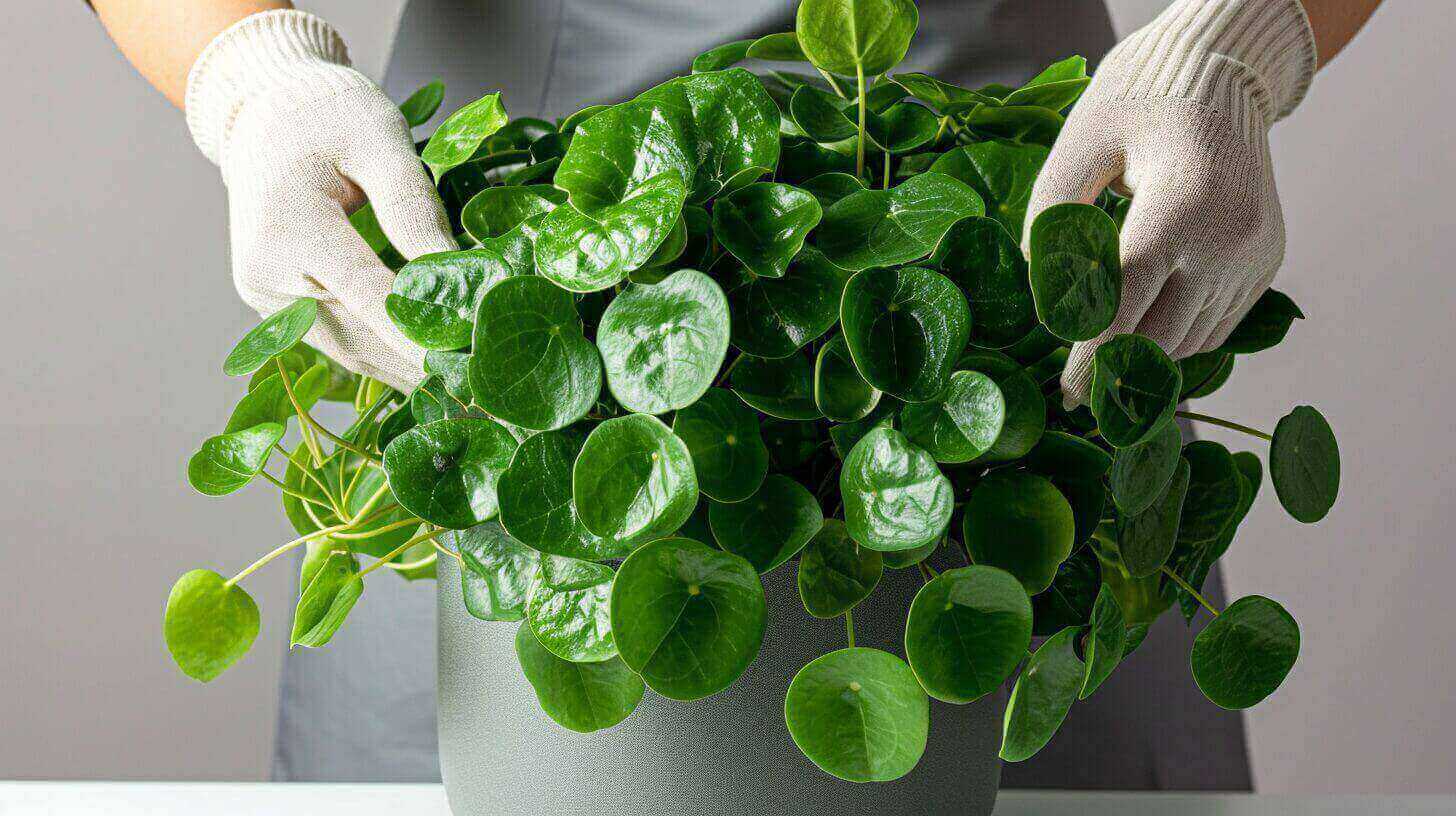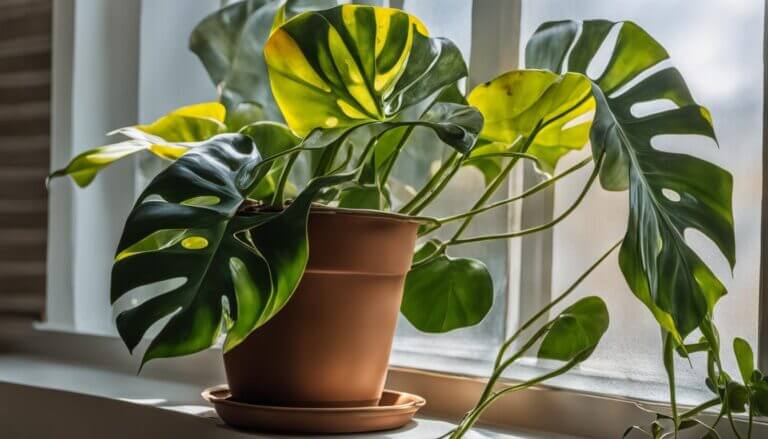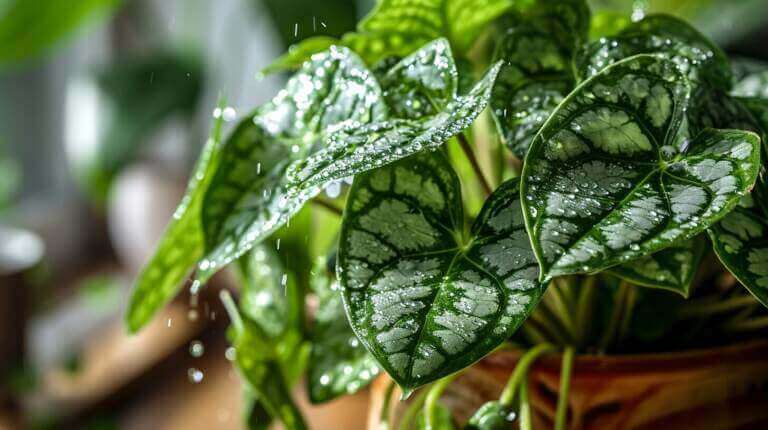How to Prune a Pilea Peperomioides? When and How to Trim Your Chinese Money Plant
Pruning is an essential skill to learn when caring for a Pilea Peperomioides plant, commonly known as the Chinese Money Plant, UFO Plant and Pancake Plant. By mastering the art of pruning, you can ensure the health and vitality of your plant while maximizing its growth potential. In this article, I will guide you through the step-by-step process of pruning a Pilea Peperomioides, providing you with valuable tips along the way.
Key Takeaways:
- Pruning is crucial for the overall health and growth of your Pilea Peperomioides.
- Regular pruning promotes new growth, ensures a compact shape, and prevents issues like fungal infections.
- Identify and remove dead or damaged leaves, trim leggy stems, and create better airflow by pruning overcrowded areas.
- Maintain at least a few healthy leaves on each stem to support photosynthesis.
- Consider propagating your pilea through stem cuttings to grow new plants.
Understanding Pilea Peperomioides Care Indoors
Before diving into the art of pruning, it’s essential to have a solid understanding of the overall care needs of the Pilea Peperomioides, also known as the Chinese Money Plant. This popular indoor plant requires specific conditions to thrive.
The Chinese Money Plant thrives in bright, indirect light. Placing it near a north or east-facing window is ideal. Direct sunlight can cause leaf burn, so it’s important to avoid exposing the plant to harsh rays. If natural light is limited, you can also use artificial grow lights to provide the necessary brightness.
When it comes to watering, it’s important to strike a balance. Overwatering can lead to root rot, while underwatering can cause the leaves to wilt. Allow the top inch of soil to dry out before watering again. Remember, it’s always better to underwater than overwater.
Proper soil and fertilization are also key factors in caring for Pilea Peperomioides. Use well-draining potting soil to prevent standing water and root rot. Fertilize the plant once a month during the growing season with a balanced plant food. This will provide the necessary nutrients for healthy growth.
The Benefits of Pruning Your Pilea Peperomioides
Pruning your Pilea Peperomioides offers a multitude of benefits that contribute to the overall health and appearance of your plant. By removing dead or damaged leaves, you can enhance the plant’s aesthetics and prevent any potential diseases from spreading. Pruning also stimulates new growth, resulting in a fuller and more compact plant. The improved airflow and light penetration due to pruning helps prevent issues such as fungal infections or pest infestations, ensuring a healthy and thriving plant.
Promoting Healthy Growth
Regular pruning of your Pilea Peperomioides encourages healthy growth by removing any weak or overcrowded stems. This allows the plant to focus its resources on the stronger stems, resulting in better overall growth and vigor. Pruning also helps maintain the plant’s shape and prevents it from becoming leggy or unruly. By shaping your Pilea through strategic pruning, you can create a more aesthetically pleasing and compact plant.
Maximizing Growth Potential
Pruning is a key practice for maximizing the growth potential of your Pilea Peperomioides. By selectively removing stems or branches, you can direct the plant’s energy towards areas that require more growth or balance. This not only results in a more symmetrical and visually appealing plant, but it also helps ensure that each part of the plant receives sufficient nutrients and light. By harnessing the power of pruning, you can unlock the full growth potential of your Pilea Peperomioides.
| Benefits of Pruning | Maximizing Growth Potential | Promoting Healthy Growth |
|---|---|---|
| Enhances plant aesthetics | Directs energy towards desired areas | Removes weak or overcrowded stems |
| Prevents disease spread | Creates a visually pleasing plant | Maintains plant shape |
| Stimulates new growth | Improves overall growth and vigor | Prevents legginess and unruliness |
| Enhances airflow and light penetration | Allows for balanced growth |
How to Prune a Pilea Plant: Step-by-Step Care Guide
Pruning your Pilea Peperomioides is a simple yet essential task to maintain its health and promote new growth. By following these step-by-step instructions, you can effectively prune your plant and ensure its continued vitality.
Step 1: Identify and Remove Damaged Leaves
Start by inspecting your Pilea Peperomioides for any dead or damaged leaves. These leaves are often discolored, wilted, or have brown spots. Using sharp pruning shears, carefully cut these leaves at the base of the stem. Removing damaged leaves not only improves the overall appearance of the plant but also prevents the spread of diseases.
Step 2: Trim Leggy Pilea Plant or Overgrown Stems
Next, look for any stems that are leggy or overgrown. These stems may cause the plant to become unbalanced or lose its compact shape. Using your pruning shears, trim these stems back to a desired length. By doing so, you encourage new growth and maintain a more aesthetically pleasing form for your Pilea Peperomioides.
Step 3: Prune Overcrowded Areas
Lastly, assess your plant for any overcrowded areas where the leaves or stems are densely packed. These areas may impede air circulation and light penetration, which can lead to fungal infections or pest issues. Prune away any overcrowded sections, creating space between the leaves and stems to promote healthier growth and prevent potential problems.
| Step | Instructions |
|---|---|
| Step 1 | Identify and remove damaged leaves at the base of the stem. |
| Step 2 | Trim leggy or overgrown stems to encourage new growth. |
| Step 3 | Prune overcrowded areas to improve air circulation and prevent issues. |
Remember to clean your pruning shears between cuts by wiping them with rubbing alcohol or a mild bleach solution. This helps prevent the spread of pathogens that may harm your plant. Regular pruning, when done correctly, will keep your Pilea Peperomioides healthy and flourishing, allowing you to enjoy its beauty for years to come.
Best Practices for Pruning Pilea Peperomioides
When it comes to pruning your Pilea Peperomioides, there are several best practices to keep in mind. These practices will help you maintain a healthy plant and encourage optimal growth. Here are some key tips:
- Always aim to maintain at least a few healthy leaves on each stem. This will ensure that the plant can continue to photosynthesize effectively and remain healthy.
- Consider propagating your pilea through stem cuttings. This is an excellent way to grow new plants from the pruned stems. Simply take a healthy stem cutting, remove the lower leaves, and place it in water or moist soil until it develops roots.
- Regularly inspect your plant for any signs of pests or diseases. Catching and addressing these issues early can prevent them from spreading and causing further damage. If you notice any problems, take appropriate action to treat the issue.
| Best Practices for Pruning Pilea Peperomioides |
|---|
| Maintain at least a few healthy leaves on each stem |
| Consider propagating through stem cuttings |
| Regularly inspect for pests or diseases |
Pruning Tips for a Healthy Chinese Money Plant
When it comes to keeping your Pilea Peperomioides in optimal health, proper pruning techniques are key. In addition to following the step-by-step instructions mentioned earlier, there are a few additional tips to consider. By implementing these practices, you can ensure your plant thrives and continues to be a stunning addition to your indoor garden.
First and foremost, humidity is crucial for a Pilea Peperomioides. These plants naturally grow in tropical regions, so providing adequate moisture in the air is essential. One way to increase humidity is by misting the leaves with water on a regular basis. Alternatively, you can place a tray of water near the plant, allowing the moisture to evaporate and create a humid environment.
Another important aspect of caring for your Pilea Peperomioides is repotting when necessary. As the plant grows, it may outgrow its current pot, leading to cramped roots and limited growth. Keep an eye out for roots that are visibly circling around the pot’s bottom or sides, as this is a sign that it’s time to repot. When repotting, select a pot with adequate drainage to prevent overwatering and root rot.
Regular fertilization is also crucial for maintaining the health of your Pilea Peperomioides. During the growing season, which typically runs from spring to summer, fertilize your plant with a balanced liquid fertilizer. This will provide the necessary nutrients to support robust growth and vibrant foliage. Be sure to carefully follow the instructions on the fertilizer packaging to avoid overfertilization, which can harm the plant.
Table: Pruning Tips for a Healthy Pilea Peperomioides
| Tip | Description |
|---|---|
| Maintain humidity | Mist the leaves or place a tray of water nearby to increase humidity. |
| Repot as needed | Monitor root growth and repot when the plant becomes rootbound. |
| Fertilize regularly | Apply a balanced liquid fertilizer during the growing season for optimal nutrition. |
| Monitor light exposure | Avoid placing the plant in direct sunlight, as it can cause leaf burn. |
Common Pruning Mistakes to Avoid
While pruning is essential for maintaining the health of your Pilea Peperomioides, it’s important to be aware of common mistakes that can hinder its growth. One common mistake is overwatering, which can lead to root rot and yellowing leaves. It’s crucial to find the right balance between watering and allowing the soil to slightly dry out between waterings. This will help prevent waterlogged soil and promote healthy growth.
Another mistake to avoid is damaging healthy leaves while pruning. Take your time and carefully assess each leaf before making any cuts. Ensure that you only remove dead or damaged leaves, preserving the healthy ones. By taking a cautious approach, you can maintain the overall health and appearance of your Pilea Peperomioides.
In addition, make sure to clean your pruning shears between cuts to prevent the spread of diseases. This simple step can go a long way in keeping your plant healthy and free from infections. Remember to wipe the blades with rubbing alcohol or a disinfectant solution before moving on to the next cut.
By being mindful of these common pruning mistakes and following the proper techniques, you can ensure successful pruning and promote a healthy and thriving Pilea Peperomioides in your home.
Table: Common Pruning Mistakes and How to Avoid Them
| Mistake | Consequence | Prevention |
|---|---|---|
| Overwatering | Root rot, yellowing leaves | Allow soil to slightly dry out between waterings |
| Damage to healthy leaves | Impaired plant health and appearance | Assess each leaf carefully before pruning |
| Failure to clean pruning shears | Spread of diseases | Wipe blades with rubbing alcohol or disinfectant between cuts |
FAQ
What is a Pilea Peperomioides?
The Pilea Peperomioides, also known as the Chinese Money Plant, is a popular houseplant known for its coin-shaped leaves and easy care. It’s native to southern China and is a perennial plant.
How do I prune a Pilea Plant?
Pruning your Pilea Peperomioides helps to maintain its shape and promote new growth. Use clean, sharp pruning shears to remove any leggy stems or dead or damaged leaves. Always make your cuts at the base of the stem.
How often should I water my Pilea Peperomioides?
Water your Pilea Peperomioides when the top inch of soil feels dry to the touch. Overwatering can lead to root rot, a common problem with many types of houseplants.
How do I propagate a Pilea Peperomioides?
Propagating Pilea Peperomioides is easy. Simply take a cutting from the base of the plant, place it in water until roots develop, and then pot it in a well-draining potting mix.
What are some common problems with Pilea Peperomioides?
Common problems with Pilea Peperomioides include yellowing leaves (often due to overwatering), drooping or wilting (underwatering), and pest infestations.
What is the ideal humidity for a Pilea Peperomioides?
Pilea Peperomioides prefers a moderate level of humidity. If your home is very dry, you can increase humidity by placing your plant on a tray filled with pebbles and water.
Why is my Pilea Peperomioides becoming leggy?
Leggy growth in Pilea Peperomioides is often a sign that the plant is not getting enough light. Move it to a brighter location with indirect light to encourage more compact growth.







